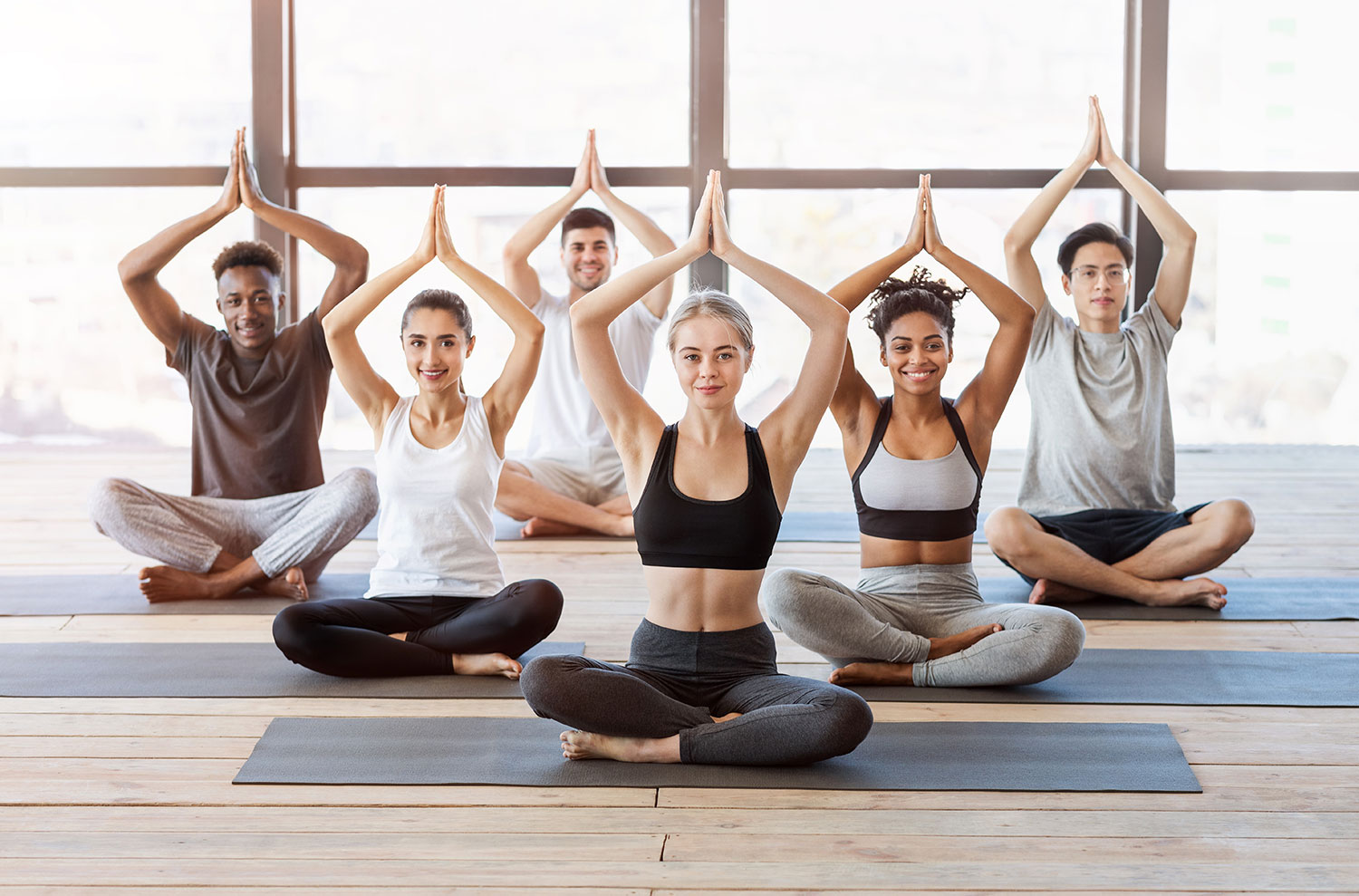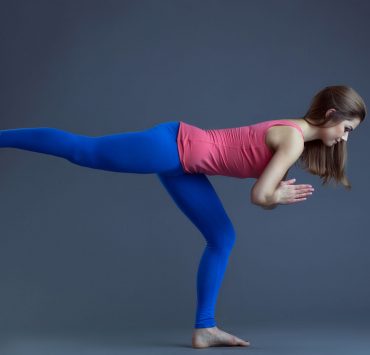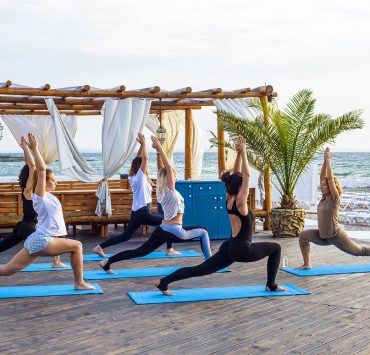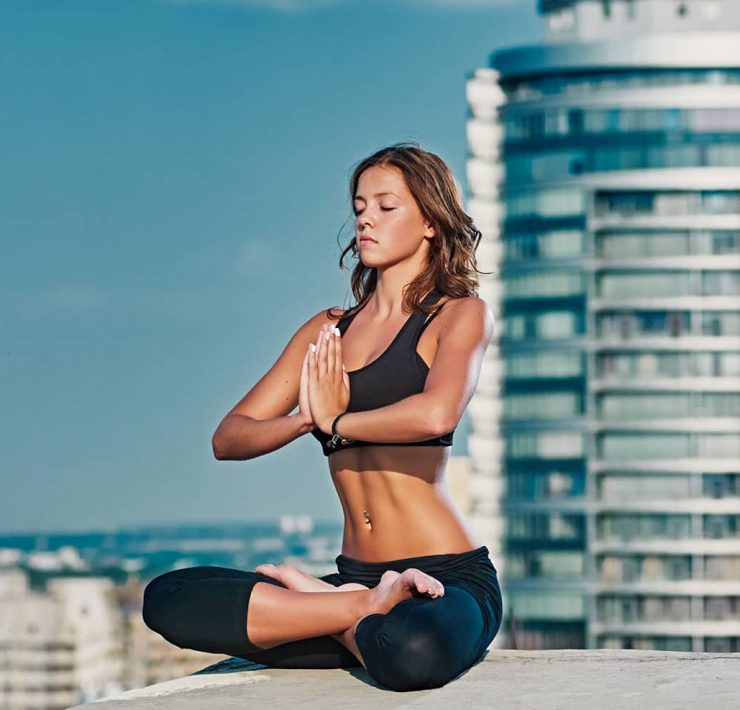
Meditation coach by day and writer by night - Shirley…
Congratulations! You’ve started attending yoga classes at your local studio!
Yoga can be a wonderful way to energize the body and bring focus and clarity to the mind. A regular practice can be truly life changing.
Let’s be honest though, a yoga class can be a bit overwhelming for the beginner, especially if things get sweaty, crowded or difficult. Plus, being surrounded by a lot of bendy people who seem to know exactly what’s coming up next can be super intimidating.
If you’re concerned about feeling out of place, it’s a good idea to learn a thing or two about basic yoga etiquette. Understanding a few of the do’s and don’ts can keep you comfortable, make your teacher’s job a little bit easier and help everyone in the room get the most out of their practice.
Before Class

There are a lot of different types of yoga class out there.
Some are vigorous, athletic workouts and some involve barely any movement at all. Some are based on traditional approaches that date back at least a hundred years and some are modern fusions of yoga with other physical disciplines and workout styles.
It’s important to know the basic format of the class so that you don’t walk into a Power Vinyasa class expecting a Yin class or vice versa.
Make sure the class is level appropriate. Many studios will note which classes are appropriate for beginners and which are intended for more advanced students.
Teachers are usually more then happy to offer modifications to less advanced students in these classes but if it’s a large group this won’t always be practical. There’s no real standardization from studio to studio so when in doubt, just ask.
It’s also important to note the temperature of the class. Many studios offer classes in rooms that have been heated to up to 40 degrees Celsius. If this isn’t your thing it’s best to avoid these classes.
Arrive Early
All yoga studios will require you to fill out a sign up sheet and a waiver when you come to your first class. Make sure you allow about 20 minutes for this if you’re a new student.
Otherwise, it’s good etiquette to arrive 5 – 10 minutes prior just so the class can begin on time without disruption.
If you do show up a bit late most teachers will allow you to join the class. Within reason. Always best to ask at the front desk.
Come Prepared

The best way to ensure a successful class is to prepare for a successful class! Make sure to wear clothes that you can move around and work up a sweat in.
No need to shell out for expensive yoga pants, a pair of gym shorts and a t-shirt will do just fine.
It’s a good idea to keep hydrated, even in slower paced classes. So bring a water bottle along. If it’s a hot class bring a towel as well.
Do you have your own yoga mat? Most studios have mats to rent or borrow but it’s always a good idea to check.
Make sure your mat is appropriate for the style of yoga you’re doing. People will sometimes arrive to class with big foam pads, an inch or more in thickness, that otherwise have the proportions of a yoga mat. These might be alright for seated stretches but are not appropriate for any yoga class with standing poses or dynamic movements.
A good yoga mat should be no more then half an inch in thickness.
Valuables
If a studio doesn’t have proper locker facilities they may allow personal items in the studio to help students protect their valuables. If they do, make sure to keep your things well clear of other students and ensure the teacher has a clear path through the room.
And most importantly; If your phone, tablet or computer is in the room, turn it off.
Don’t Wear Socks

Yoga teachers are obsessed with feet. You might be thinking about the burn in your glutes or hamstrings, but your teacher’s probably looking at your feet.
Is the big toe mound rooting down? Are you pressing through the inside or outside of your heel? Are you collapsing through your arch?
Standing poses are all about foundation, and that means having an unrestricted connection between your foot and the floor. Trust me. A yoga teacher worth their salt wants to see your feet. So don’t wear socks.
Plus, socks are slippery which will make every standing pose harder and less safe.
Glasses
Wearing your glasses in a yoga class is totally fine. That being said, if things start to get sweaty or slippery and you want to take them off make sure you put them on a block or a ledge somewhere and never directly on the floor.
When I was just starting out I had a yoga teacher step on my glasses. That was the most expensive yoga class I’ve ever taken.
Don’t Wear Perfume/Cologne

Yoga studios can get pretty sweaty, which means they can also get a bit smelly at times.
It’s understandable that you might want to wear a scent to mask it. However, a lot of people find perfume and cologne distracting or physically irritating when they’re trying to breathe deeply through their nose.
Some people even have serious sensitivities or allergies.
A small amount of natural essential oils is probably not going to bother anyone, but exercise caution.
Let the Teacher Know if You Have any Injuries or Mobility Issues
First of all, make sure you get the all clear from your health-care provider before starting a yoga program if you have a pre-existing injury or mobility issue.
If you get the green light, make sure when you enter a class for the first time that you let the teacher know about your issue. Depending on the problem certain poses and adjustments that would ordinarily be perfectly safe could become quite dangerous.
A good yoga teacher will know how to modify the poses for different bodies and might even have some insights to help you get the most out of the practice.
During Class

It’s always nice to get your favourite spot in a yoga class. Whether it’s right up front where you don’t have so many other students in your sight line; or in the back corner where the teacher might be more likely to leave you alone and let you do your thing.
Being near a wall can be nice if you’re learning inversions; and of course everyone likes to have a little extra personal space.
The trouble is, once a class starts to fill up, you may need to move to accommodate others. Most studios have a limit to the amount of students they’ll take in a class, but by then you’re usually pretty packed in.
Studios with popular classes usually have little markers on the floor to indicate how they want the mats organized in a full class. You can avoid moving if you place your mat in front of one of these markers at the beginning.
Another thing to pay attention to if you’re in a crowded class is where your hands are relative to other peoples bodies. Accidental physical contact is not always awkward, but it can be.
Be mindful, and if you touch someone by accident, apologize.
Don’t Talk to Other Students During Class
So you’ve finally managed to get your significant other (or your co-worker or your buddy) out to a yoga class after bugging them for years, and now they’re here and they’re doing it all wrong.
It can be tempting to correct your friend, especially if they can’t seem to tell right from left, but it can be very distracting for the other students; not to mention your friend, the teacher and yourself.
Focus on your own practice, let the teacher do their job and remember that yoga is a process.
The same goes for gossip or small talk. Keep it to a minimum.
Don’t Stare

People who practice a lot of yoga can sometimes do beautiful and impressive things with their bodies. This doesn’t mean they aren’t self-conscious, and it definitely doesn’t mean they’re trying to show off.
It’s OK to look around the room a little bit, but do your best to stay focused on your own experience and try not to compare yourself to other people.
If You’re Not Comfortable, Say So
Some styles of yoga can involve hands on adjustments or detailed alignment cues that are appropriate for some bodies some of the time but may not be appropriate for you, today. It is never considered bad etiquette to refuse an adjustment or an instruction if you don’t want it.
If something doesn’t feel right, speak up.
Modify, Within Reason

Sometimes you think you have enough gas in the tank for that level 2 core power flow class and then you get going and you realize…nope, not today.
It’s OK to hold back or modify poses to make them easier or less stressful on the body.
It’s also OK to take Childs Pose or Savasana at any time and cut out difficult sequences entirely.
It’s even OK to do your own thing a little bit and take some restorative or yin poses that the rest of the class isn’t doing. It’s your practice.
Just be mindful that when someone in a led class launches in to sequences and exercises that don’t fit with the flow of the class it can be confusing for other students, especially beginners, who look to others to see if they’re doing things right. It can also be stressful for the teacher whose job is, in part, to keep everybody safe.
So modify, within reason.
After Class

Most yoga classes end with a period of silent rest known as Savasana.
Some teachers will guide students into and out of the pose during the allotted class time. However, it has become more and more common for classes to simply end with Savasana which allows students who are in a hurry to get up and leave and students who would like a bit more rest to take their time.
If this is the case, and you choose to leave the room while other people are still resting, make sure to be extra quiet putting away props and gathering your things. Wait until you’re outside of the room to talk to others or ask questions of the teacher.
Clean up After Yourself
This should go without saying.
Put away props. Spray and wipe down your mat. Return any items borrowed from the studio to their proper places.
Sometimes cheaper mats can shed little bits of mat fluff, make sure to check and do your best to tidy them up.
Some studios have people on staff to wipe down and reorganize borrowed mats, in which case you can probably leave your mat on the floor and not worry about it. As always, ask if you’re not sure.
Talking to the Teacher After Class

Yoga teachers love to talk to their students. If you have a question or comment or just want to introduce yourself feel free to chat!
Just bear in mind that after a busy class there might be several people waiting to talk to the teacher. If so, try to keep things short, so everyone can have their questions or concerns addressed.
The Bottom Line
The whole point of yoga is to help people become happy, healthy and relaxed. So try not to get too stressed out about etiquette.
It’s ok to not know everything. If we knew everything about yoga, we wouldn’t need to go to yoga classes!
As long as you come to class with an open mind and a positive attitude then you’re already halfway there. The key thing is just to be mindful and respectful of others.
So don’t worry, be happy and go do some yoga already!
What's Your Reaction?
Meditation coach by day and writer by night - Shirley has perfected the art of finding a healthy balance in life. She’s eager to spread calm energy and share her zen tips through conscious writing.














